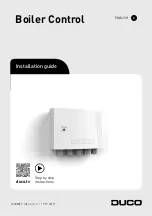
47
COMMISSIONING AND MAINTENANCE
Parameter 2130 (user level)
The parallel shift of the climatic curve is used to modify, in a
uniform way, the delivery temperature for the whole scale of the
external temperature. Changing the value of this parameter will
correct the climatic curve if the ambient temperature is too high
(set a negative value) or too low (set a positive value). If there is
an Open Therm thermostat, this value is not considered.
This parameter allows the user to directly and easily increase
(positive value) or decrease (negative value) the delivery tem-
perature to the heating system and thus the ambient temper-
ature.
T delivery
(°C)
T outside (°C)
Tset min (°C)
Tset max (°C)
Par. 2130
Par. 2024
Par. 2023
Par. 2120
Par. 2122
Par. 2125
Par. 2119
Par. 2121
Parameter 2134 (installer level)
Each building has its own thermal characteristics, therefore
the time needed to set up the heating system can differ even
among buildings located in the same area, with the same ex-
ternal temperature.
By using this parameter it is possible to modify the heating sys-
tem reactivity adapting its response to the thermal character-
istics of the building and thus optimising the environmental
comfort.
Modifying the setting of this parameter (0-100%) increases or
decreases the speed at which the delivery temperature changes
according to the external temperature change.
Setting a higher value will improve the building insulation.
Example:
− 0%: The delivery temperature changes quickly when the
external temperature changes.
− 100%: The delivery temperature changes slowly when the
external temperature changes.
The request is enabled upon the closing of the ambient ther-
mostat/heat request contact, provided that the external tem-
perature does not exceed the value defined by parameter 2125.
If the external temperature exceeds that set in parameter 2125,
the burner stops even in the presence of a heat request.
9
If the external probe (accessory) is not detected (not in-
stalled or damaged), the system makes a heat request at
the maximum setpoint set (Par. 2024).
Mode 2
: continuous operation with variable setpoint and ex-
ternal probe (accessory) and ambient thermostat (AT) night re-
duction
In this mode:
− The external probe (accessory) is necessary to enable the
thermal unit operation.
− The OpenTherm (OT) communication is not enabled and
any OT thermostat connected is supplied but signals a
“communication error”.
− Input 0-10V is not used.
− The Modbus communication is not enabled.
The equipment works with a variable setpoint defined by the
climatic curve (which can be set as described in mode 1) accord-
ing to the external temperature. The heat request is active re-
gardless of the closing of the ambient thermostat/heat request
contact and stops only when the external temperature is higher
than that defined by the parameter 2125.
Par.
No.
Description
2131
Main Zone/Zone 1 mild climate external temperature
compensation.
2119
Main Zone/Zone 1 heating setpoint at the minimum
external temperature.
2120
Main Zone/Zone 1 minimum external temperature.
It defines the minimum external temperature to
which the maximum heating setpoint Par. 2119 must
be associated.
2121
Main Zone/Zone 1 heating setpoint at the maximum
external temperature (Par. 2122)
It sets the minimum heating setpoint when the
external temperature is equal to the value set in pa-
rameter 2122 (basic external temperature).
2122
Main Zone/Zone 1 maximum external temperature.
It sets the external temperature at which the boiler
setpoint must be reduced, according to the value
defined in parameter 2121.
2023
Minimum heating setpoint.
2024
Maximum heating setpoint.
2125
Main Zone/Zone 1 summer/winter switching.
It blocks the heating request when the external tem-
perature is greater than this setpoint.
2130
Parallel shift of main Zone/Zone 1 climatic curve.
2133
Main Zone/Zone 1 setpoint night reduction in heating
mode Par. 2001 = 2 or 3.
It defines by how many degrees the heating setpoint
will be reduced at the opening of the ambient ther-
mostat (AT) contact.
The reduction of the delivery temperature affects all
the active heating zones and it can be used when the
AT terminal of every zone regulator is jumpered.
2134
Compensation factor of external temperature.
The parameter 2133 defines by how many degrees the setpoint
decreases (night reduction) when the ambient thermostat/heat
request contact opens.
T delivery
(°C)
T outside (°C)
Tset min (°C)
Tset max (°C)
Par. 2131
Par. 2024
Par. 2023
Par. 2120
Par. 2122
Par. 2125
Par. 2119
Par. 2121
9
If the external probe (accessory) is not detected (not in-
stalled or damaged), the system makes a heat request at
the maximum setpoint set on the climatic curve.
















































